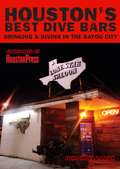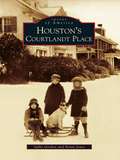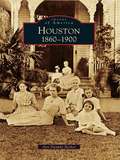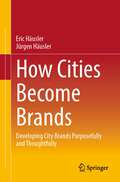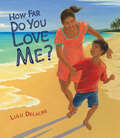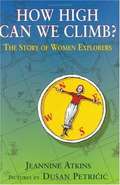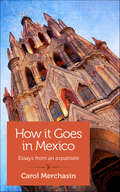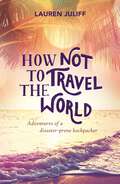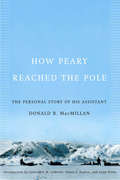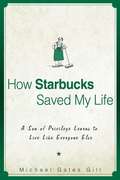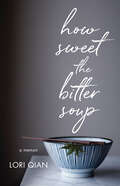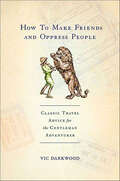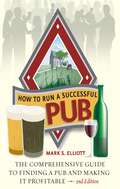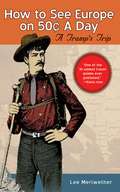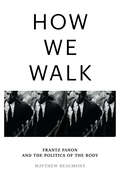- Table View
- List View
Houston's Best Dive Bars
by John Nova LomaxHouston, that sun-drenched, humidity-steamed subtropical megapolis, might not be the first place you think of when you rattle off great American drinking towns. When most outsiders think of the city at all, images of cowboys, astronauts and oilmen come to mind. And truth be told, many natives wrestle with the concept of a dive bar, thinking that any gin mill that lacks a velvet rope, bottle service and a valet parking service is a dive.In Houston's Best Dive Bars, award-winning journalist (and third-generation Houstonian) John Nova Lomax sets the record straight on what exactly a dive is (and isn't) in the Bayou City. From Korean houses of ill repute on Telephone Road to bluesy Third Ward juke joints, from Galveston County bayside gang haunts to Spring Branch redneck redoubts, from famous old Inner Loop standbys like the Lone Star Saloon and the West Alabama Ice House to obscure gems like the D&W Inn and the Sundown Saloon, Lomax drank, and with this book as evidence, lived to tell the dive-y tales. The result is the first of its kind and the only guidebook to drinking and diving in Houston you will ever need.
Houston's Courtlandt Place
by Penny Jones Sallie GordonIn 1906, Houston was poised to become a great city. The construction of its first skyscraper began (only eight stories); dredging commenced for the Houston Ship Channel; and Carrie Nation paid a visit and inflicted $750 damage on a saloon named after her, leaving no doubt that she wanted the name changed. Rambunctious growth, the proliferation of streetcar lines, and the emergence of the automobile pushed Houston's boundaries outward. When unrestricted commercialism encroached on the mansions of the city's elite, they abandoned downtown and formed private residential enclaves beyond the chaos. One of the earliest, fashioned after the "private places" of St. Louis, was Courtlandt Place. Developed for Houston's first big businessmen and power brokers, its story has been linked with the city's history for more than 100 years. The exceptional Courtlandt Place is on the National Register of Historic Places and remains a triumph of historic preservation.
Houston's River Oaks (Images of Modern America)
by Ann Dunphy Becker Charles Dain Becker Joan Blaffer JohnsonRiver Oaks is a name that has rung out in Houston, Texas, since its founding in 1923. The neighborhood's uncertain geographical boundaries may be a point of controversy, but the impact River Oaks has had on the city is indisputable. River Oaks has been home to astronauts who have contributed to American space exploration; lawyers who are involved in the interworking of the United States' legal system; oil tycoons who have helped Houston grow; and doctors who are responsible for inventing lifesaving medical procedures. The neighborhood is also home to one of the country's most exclusive country clubs, and River Oaks has been served by some of the same schools, churches, stores, and restaurants since its founding. This book explores how River Oaks not only celebrates, grieves, and lives life day-to-day, but also how it changes the world.
Houston: 1860 to 1900
by Ann Dunphy BeckerIn an area that was little more than a thick forest lining Buffalo Bayou, Houston was founded in 1836 by the Allen brothers and named after the Republic of Texas's beloved general Sam Houston. By 1860, there were 5,000 residents in Houston, wooden sidewalks, a few shell-paved roads, and five railroads. Out of the mud and mayhem of Houston's humble frontier beginnings arose men like Thomas W. House, Alexander P. Root, Edward Hopkins Cushing, Thomas Bagby, and William S. Swilley. The sleepy little bayou that wound from Main Street and emptied into Galveston Bay would soon become one of the largest ports in the south. By 1900, the founders' grandchildren were ready to strike out on their own and would play their part in building a great Texas city, a railroad nexus for the Gulf Coast, and an international port of call.
Houstorian Dictionary, The: An Insider's Index to Houston
by James GlassmanHouston is an innovative city informed by a diverse and eclectic past that is ever-present in its customs, expressions and dreams, even though most Houstonians don't realize it. Represented by landmarks, dishes and events, the culture of America's fourth-largest city is celebrated in the literature, movies, songs and memorable quotations credited to its vibrant citizenry. The Houstorian Dictionary is a guide for natives and newcomers alike. Each entry leads into the next to create a tapestry of the Bayou City's past and present. Discover that story and visit the places where it all happened. Meet the innovators, heroes, hucksters and misfit tinkerers who share the unique Houston DNA. The Houstorian, James Glassman, reveals valuable insights that make this a handy reference as well as an entertaining read.
How Ben Franklin Stole the Lightning
by Rosalyn SchanzerBen Franklin was the most famous American in the entire world during colonial times. No wonder! After all, the man could do just about anything. Why, he was an author and an athlete and a patriot and a scientist and an inventor to boot. He even found a way to steal the lightning right out of the sky.<P><P> Is such a thing possible? Is it. Take a look inside and find Ben busy at work on every spread. Then find out how he used his discovery about lightning to make people's lives safer.<P> In an inventive way, Rosalyn Schanzer brings us a brilliant and ever-curious American original.
How Cities Become Brands: Developing City Brands Purposefully and Thoughtfully
by Jürgen Häusler Eric HäuslerThis book explores how the fragile and lengthy process of developing a city brand can be carefully managed. Necessary background information is explained, numerous experiences are reported, and targeted city branding is inspired in a variety of ways.The dream of every brand maker: to develop a city into a strong city brand - perhaps even a myth. The creation of myths remains a curiosity. Is it targeted, are there relevant recipes for success, and can those responsible be identified? Above all: Can the process be replicated? How do brand makers deal with the complexity of the phenomena of cities and city brands? How do they give the arduous process of creating a city brand a reasonable chance of success? How do brand makers deal with the often biting criticism from outside and the nagging self-doubt?Successful cityscapes arise from the trials and tribulations of complex and sometimes random processes. In the course of global city competition, this evolutionaryprocess is enriched with the achievements of the craft of branding. This is not a guarantee of success. Success depends on numerous prerequisites, which are discussed in detail. Finally, craft rules for good and at the same time sensitive city branding are mentioned.The translation was done with the help of artificial intelligence. A subsequent human revision was done primarily in terms of content.nal criticism and self-doubts?City images emerge from complex and random processes. In global urban competition, this process is enriched with brand making achievements. Success isn't guaranteed, depending on discussed conditions. Lastly, rules for effective city branding are outlined.nal criticism and self-doubts?City images emerge from complex and random processes. In global urban competition, this process is enriched with brand making achievements. Success isn't guaranteed, depending on discussed conditions. Lastly, rules foreffective city branding are outlined.nal criticism and self-doubts?City images emerge from complex and random processes. In global urban competition, this process is enriched with brand making achievements. Success isn't guaranteed, depending on discussed conditions. Lastly, rules for effective city branding are outlined.nal criticism and self-doubts?City images emerge from complex and random processes. In global urban competition, this process is enriched with brand making achievements. Success isn't guaranteed, depending on discussed conditions. Lastly, rules for effective city branding are outlined.nal criticism and self-doubts?City images emerge from complex and random processes. In global urban competition, this process is enriched with brand making achievements. Success isn't guaranteed, depending on discussed conditions. Lastly, rules for effective city branding are outlined.nal criticism and self-doubts?City images emergefrom complex and random processes. In global urban competition, this process is enriched with brand making achievements. Success isn't guaranteed, depending on discussed conditions. Lastly, rules for effective city branding are outlined.nal criticism and self-doubts?City images emerge from complex and random processes. In global urban competition, this process is enriched with brand making achievements. Success isn't guaranteed, depending on discussed conditions. Lastly, rules for effective city branding are outlined.City images emerge from complex and random processes. In global urban competition, this process is enriched with brand making achievements. Success isn't guaranteed, depending on discussed conditions. Lastly, rules for effective city branding are outlined.City images emerge from complex and random processes. In global urban competition, this process is enriched with brand making achievements. Success isn't guaranteed, depending on discussedconditions. Lastly, rules for effective city branding are outlined.City images emerge from
How Consumers Pick a Hotel: Strategic Segmentation and Target Marketing
by William Winston Dennis J CahillVenture through the pages of How Consumers Pick a Hotel to learn the steps of selecting a target and using consumer behavior applications to segment the market to reach your target. Much as a consumer goes through the process of selecting a satisfying hotel, you can choose to use the information provided to make your hospitality career relaxing and satisfying. When you finish this fantastic reading journey, you’ll be prepared to offer services that meet the public’s demands, and you’ll possess the prerequisite knowledge and skills for developing your own strategic approach to a target market. As the many methods of segmentation are discussed in detail, you will also learn effective strategies for communicating with multiple segments. Ideal as a supplementary text for marketing and hospitality marketing courses, How Consumers Pick a Hotel provides a concise overview of consumer behavior and intertwines marketing theory with sound ways in which to implement the theory. This will both orient you and give you a solid base for understanding the principles in question. You will quickly grasp the various methods of segmentation, and the book’s “real-life” segmentation schemes will teach you how to apply them in day-to-day business.As the many methods of segmentation are discussed in detail, you will learn effective strategies for communicating with multiple segments. In the end, you will have acquired the prerequisite knowledge and skills for developing your own strategic approach to a target market. How Consumers Pick a Hotel is suitable both as a reference guide for practicing marketing managers and hospitality professionals who specialize in marketing and as a companion text for graduates and undergraduates who need to know the ABCs of target marketing. You’ll turn to it again and again for guidance and practical, easy suggestions!
How Did They Do That?
by Caroline SuttonThe totally satisfying answers to more than 100 questions that drive normal people—not to mention infomaniacs and trivia buffs—crazy.Questions about matters great and small, from ancient times to yesterday.Illustrated with illuminating technical drawings and unusual vintage photographs.How did they spend $40 million making Heaven's Gate?How did they decide the length of a mile?How did Beethoven compose when he was deaf?How did they discover the Hope diamond?How did they know the size of the Earth over 1,700 years before anyone sailed around it?How did they set the price of the Louisiana Purchase?How did the FBI devise the "Ten Most Wanted" list?How did they decide which horses were Thoroughbreds?How did they pick the Four Hundred?How did they start the Guiness Book of World Records?How did the Indians decide that cows were sacred?How did they discover penicillin?How did they build the Great Pyramid at Giza?How did they decide how tall to make the Empire State Building?How did they know there was an El Dorado?How did they start the Chicago fire of 1871?How did Hannibal cross the Alps?
How Far Do You Love Me?
by Lulu DelacreThis unique bedtime book by award-winning author-illustrator Lulu Delacre features a game that highlights the universal love between caregivers and children while taking readers on a journey across the seven continents of Earth.How far do you love me?I love you to the top of the peakslit by the morning sun ...To the crests of the desert where the wind sweeps sand from the dunes ... Based on a bedtime game that author-illustrator Lulu Delacre played with her young daughters, How Far Do You Love Me? is an "I love you" book with a twist. With every expression of love, readers visit a different location around the world, each a beautifully illustrated scene of caregivers and children in a place of natural beauty. The intimate size of the book is just right for sharing and snuggling up close with a child. As bedtime--or any quiet time--approaches, gather close with a special person in your life and get ready to let your imagination soar to place after place as you embark on a game of "How far do you love me?" The possibilities are endless!
How Hard Can It Be?: The World According to Clarkson Volume 4 (The World According to Clarkson)
by Jeremy ClarksonHow Hard Can it Be? is the fourth hilarious volume in Jeremy Clarkson's The World According to Clarkson series.How hard can it be...To build a power station without upsetting the eco-mentalists? To seek world domination if you've been hit the ugly stick? For the Met Office to get yesterday's weather right?In volume four of The World According to Clarkson, Jeremy Clarkson pours scorn on the nonsensical, the dumb, the idiotic and the plain foolish in his continuing quest to discover where exactly we've all gone wrong.Along the way he ponders:• Whether conquering France might solve the immigration problem• What happened when you ignore proper warning labels • What would happen if we turned the internet offOften controversial, frequently scathing but always funnier than James May, Jeremy Clarkson shows us how we could so easily make the world a better place. Praise for Jeremy Clarkson:'Brilliant . . . laugh-out-loud' Daily Telegraph'Outrageously funny . . . will have you in stitches' Time OutNumber-one bestseller Jeremy Clarkson writes on cars, current affairs and anything else that annoys him in his sharp and funny collections. Born To Be Riled, Clarkson On Cars, Don't Stop Me Now, Driven To Distraction, Round the Bend, Motorworld, and I Know You Got Soul are also available as Penguin paperbacks; the Penguin App iClarkson: The Book of Cars can be downloaded on the App Store.Jeremy Clarkson because his writing career on the Rotherham Advertiser. Since then he has written for the Sun and the Sunday Times. Today he is the tallest person working in British television, and is the presenter of the hugely popular Top Gear.
How High Can We Climb? The Story of Women Explorers
by Jeannine AtkinsProfiles twelve women explorers of the land and sea: Jeanne Baret, Florence Baker, Annie Smith Peck, Josephine Peary, Arnarulunguaq, Elisabeth Casteret, Nicole Maxwell, Sylvia Earle, Junko Tabei, Kay Cottee, Sue Hendrickson, and Ann Bancroft.
How Iceland Changed the World: The Big History of a Small Island
by Egill BjarnasonThe untold story of how one tiny island in the middle of the Atlantic has shaped the world for centuries.The history of Iceland began 1,200 years ago, when a frustrated Viking captain and his useless navigator ran aground in the middle of the North Atlantic. Suddenly, the island was no longer just a layover for the Arctic tern. Instead, it became a nation whose diplomats and musicians, sailors and soldiers, volcanoes and flowers, quietly altered the globe forever. How Iceland Changed the World takes readers on a tour of history, showing them how Iceland played a pivotal role in events as diverse as the French Revolution, the Moon Landing, and the foundation of Israel. Again and again, one humble nation has found itself at the frontline of historic events, shaping the world as we know it, How Iceland Changed the World paints a lively picture of just how it all happened.
How It Goes in Mexico: Essays from an Expatriate
by Carol MerchasinCarol Merchasin first visited San Miguel de Allende in 2005, fell in love with its language, people, and culture, and moved there full-time with her husband shortly thereafter. A lawyer by training, Merchasin is curious about how everything around her in Mexico works—the health care system, religious rituals, loaning money, small change at the market, narcotrafficantes, telenovelas, and the subtleties between the verbs ser and estar. An intrepid researcher, she informally consults her neighbors, history books, and experts until she’s satisfied. In How It Goes in Mexico, her essays are by turns funny and poignant, and her portrayal of Mexico is neither romantic nor wary, but respectful and compassionate.
How Not to Travel the World: Adventures of a Disaster-Prone Backpacker
by Lauren JuliffWhen Lauren left to go travelling, she thought she would instantly become a glamorous backpacker. But after being mugged, scammed, caught up in a tsunami and experiencing a very unhappy ending during a massage, she realised that learning how NOT to travel the world was the most enlightening experience she could have hoped for.
How Peary Reached the Pole: The Personal Story of His Assistant
by Donald MacMillanIn 1934 Donald B. MacMillan, an accomplished explorer, wrote about his early career as a member of Robert E. Peary's 1908-09 North Pole Expedition. Now available for the first time since its original publication, this expanded edition of How Peary Reached the Pole features a biography of MacMillan and thirty-six images from his hand-tinted lantern slides. MacMillan used the journal he kept during the expedition to provide an intimate view of day-to-day activities and relationships with other members of the party, detailing how he learned to drive dog teams, camp in sub-zero temperatures, and travel safely across the ice-covered Polar Sea. MacMillan's experiences and deep admiration for Peary's methods, leadership, and many accomplishments make for fascinating reading. How Peary Reached the Pole allows us to see Arctic landscapes and Inughuit culture as MacMillan experienced them, providing a perspective from which to consider the northern environmental and cultural issues that continue to concern individuals and nations today, one hundred years after Peary's historic expedition.
How Starbucks Saved My Life: A Son of Privilege Learns to Live Like Everyone Else
by Michael Gates GillThe riches-to-rags story of a middle-aged man who lost his good job and how he manages to get back humility and confidence by working at Starbucks.
How Sweet the Bitter Soup: A Memoir
by Lori QianHer mom was working as a maid. Her dad’s Alzheimer’s was in high gear. And the rent on her parents’ small Chicago apartment had just gone up. Again. But Lori was holding it all together: helping care for her dad and pay her family’s bills, figuring out how to navigate graduate school and four jobs on top of her family responsibilities, and, somehow, continuing to believe that there was more to life than this. And there was. An exciting job teaching at a prestigious school in China. Although the previous month, she had turned down a job offer in Iowa—thinking it was too far away from her family—she felt completely at ease accepting the job in China. Grasping on to the fierce determination she’d had since childhood, Lori found herself in Guangzhou, China, where she fell in love with the culture and with a man from a tiny town in Hubei province. What followed was a transformative adventure—one that will inspire readers to use the bitter to make life even sweeter.
How To Make Friends and Oppress People: Classic Travel Advice for the Gentleman Adventurer
by Vic DarkwoodNo traveler to date has matched the intrepid 19th-century gentleman for his bravery, derring-do, and ability to make a perfect cup of tea in the most malarial of climes. But the sun has set on the golden age of exploration, and the records of these fearless, mustachioed adventurers have vanished from the shelves. In their place have appeared timorous travel guides written by authors who could hardly locate Rhodesia on a classroom globe let alone comment on the proper etiquette of an Italian duel.Now, with the publication of Vic Darkwood's How to Make Friends and Oppress People, at long last today's aspiring adventurers can avail themselves of the best of classic travel advice on such invaluable topics as:-Using Anthills as Ovens-Hunting Elephants and Hippos with a Javelin-Sleeping on a Billiard Table as a Means of Avoiding Vermin -Digging a Well with a Pointy StickFully illustrated with over 150 drawings and woodcuts, this inestimable collection of wisdom drawn from actual 19th- and early 20th-century guidebooks will prove essential to any traveler looking to enjoy his excursion abroad or hoping to avoid death at the hands of inhospitable natives.
How To Run A Successful Pub
by Mark S. ElliottIf you are thinking about leaving the rat race to run your own pub, but don't know how to go about it, this book is for you. How to Run a Successful Pub provides you with all the information and advice you need to make your dream a reality. It will help you to: FIND YOUR IDEAL PUB PLAN AND SET UP YOUR BUSINESS TARGET YOUR CUSTOMERS MAKE MORE MONEY CONTROL YOUR SALES MAXIMISE YOUR PROFITS This book is packed with practical, up-to-date advice on marketing, managing staff, bookkeeping, licensing law, food, fruit machines, raising finance and the necessary regulations.
How To Run A Successful Pub: A Comprehensive Guide To Acquiring And Running Your Own Licensed Premises
by Mark S. ElliotIf you are thinking about leaving the rat race to run your own pub, but don't know how to go about it, this book is for you. How to Run a Successful Pub provides you with all the information and advice you need to make your dream a reality. It will help you to: FIND YOUR IDEAL PUB PLAN AND SET UP YOUR BUSINESS TARGET YOUR CUSTOMERS MAKE MORE MONEY CONTROL YOUR SALES MAXIMISE YOUR PROFITS This book is packed with practical, up-to-date advice on marketing, managing staff, bookkeeping, licensing law, food, fruit machines, raising finance and the necessary regulations.
How To See Europe on 50¢ a Day: A Tramp's Trip
by Lee MeriwetherThe original college-dropout backpacker that started it all-this traveler's classic is reissued here for the first time, and follows the adventures of Lee Meriwether in 1886 as he boards a steamer in Brooklyn and heads for Italy-to travel Europe on two quarters a day. Escaping a jail sentence in Italy for trying to sleep for free in the grounds of Pompeii and climbing into a volcano at midnight are just a few of the cheap adventures that Merriwether relates as he travels to Germany, Turkey, Greece, Austria, Switzerland, and England, all the while commenting on the sights he sees with an eye for social justice and his own special brand of humor.
How To Work In Someone Else's Country
by Ruth StarkWorking abroad offers adventure, friendship with people of other cultures, intimate familiarity with exciting places, and opportunities to make real differences in communities. It also presents countless challenges, ranging from packing and staying safe and healthy to balancing project objectives with on-the-ground realities, working with local officials, and forging respectful and productive relationships. These challenges and many more are tackled in "How to Work in Someone Else's Country. " Drawing on thirty years of experience as an international consultant in Africa, Asia, Latin America, and the Pacific, Ruth Stark provides guidance for anybody preparing to work in a foreign country. This easy-to-read guide is enlivened by real-life examples drawn from the author's journals and stories shared by colleagues. Slim enough to fit in a carry-on, this book is sure to come in handy wherever your work takes you.
How We Walk: Frantz Fanon and the Politics of the Body
by Matthew Beaumont"In this fascinating and wide-ranging book, Beaumont reminds us that walking is far from a neutral activity. With the help of Frantz Fanon, Beaumont locates freedom at the level of the body; free from the systems of oppression, exploitation, and harassment."–Lauren Elkin, author of FlâneuseHow race, class, and politics influence the way we moveYou can tell a lot about people by how they walk. Matthew Beaumont argues that our standing, walking body holds the social traumas of history and its racialized inequalities. Our posture and gait reflect our social and political experiences as we navigate the city under capitalism. Through a series of dialogues with thinkers and walkers, his book explores the relationship between freedom and the human bodyHow We Walk foregrounds the work of Frantz Fanon, psychiatrist and leading thinker of liberation, who was one of the first people to think about the politics of &‘walking while black&’. It also introduces us to the renegade psychoanalyst Wilhelm Reich, who wrote that one could discern the truth about a person through their posture and gait. For Marxist philosopher Ernst Bloch, the ability to walk upright and with ease is a sign of personal and social freedom.Through these excursions, Beaumont reimagines the canonical literature on walking and presents a new interpretation of the impact of class and race on our physical and political mobility, raising important questions about the politics of the body.
How Will I Know?: A life-affirming read of love, loss and letting go
by Sheila O'FlanaganSheila O'Flanagan's bestselling HOW WILL I KNOW? is a heart-wrenching and life-affirming read that should not be missed by readers of Marian Keyes and Freya North. It was love at first sight for Claire and Bill Hudson. They met at Claire's fifth birthday party and they were destined to be together for the rest of their lives. When baby Georgia came along, it was the icing on the cake. So when a tragic accident snatched Bill away, Claire felt like she'd lost everything - except Georgia. In the three years since, Claire has devoted her life to Georgia; she knows no man could ever replace Bill, and the child needs her all her attention. Now Georgia's a teenager, though, and there's one thing Claire can't advise her on: dating. And so, purely to help her lovely young daughter in her journey through the teenage years, Claire sets out on some serial dating. And destiny is watching, again...What readers are saying about How Will I Know?:'Brilliant! I loved every page of this book' Goodreads reviewer, 5 stars'Sheila O'Flanagan at her best. The book is sensitive but also light-hearted. I really would recommend this book to anyone!' Amazon reviewer, 5 stars'Light, fun and highly enjoyable - the only disappointment comes when you finish the last page' Amazon reviewer, 5 stars
